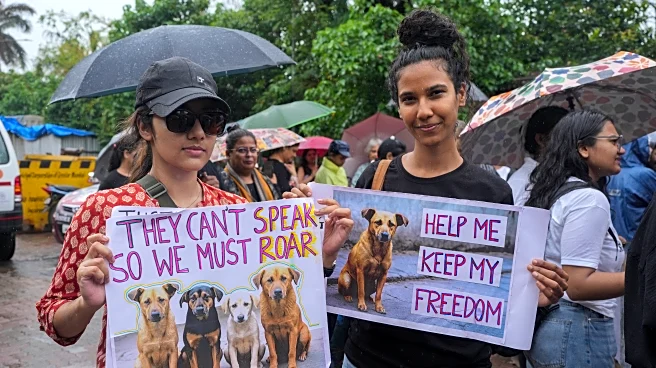What's Happening?
India's Supreme Court has revised its previous directive that mandated the relocation of all stray dogs in Delhi and its suburbs to shelters. This decision comes after significant backlash from animal welfare groups who argued that such a move would lead to overcrowding and potential culling of the animals. The court's new ruling allows for non-aggressive and non-infected stray dogs to be released back to their original locations after being vaccinated and neutered. The court also emphasized that dogs with rabies or aggressive behavior should be kept in shelters. Additionally, the court has banned the feeding of stray dogs in public spaces, designating specific areas for this purpose. The Supreme Court plans to develop a national policy on stray dogs, considering similar cases across various states.
Why It's Important?
The Supreme Court's decision is significant as it addresses the complex issue of managing the large population of stray dogs in India, which is estimated to be in the millions. The country accounts for a substantial portion of global rabies-related deaths, highlighting the public health risks associated with stray dogs. The ruling attempts to balance public safety concerns with animal welfare, a contentious issue that has sparked protests and legal challenges. The decision to allow the release of vaccinated and neutered dogs back to their original locations aligns with existing rules and is seen as a more humane approach. This ruling could set a precedent for how other regions in India manage their stray dog populations, potentially influencing public policy and animal welfare practices nationwide.
What's Next?
The Supreme Court's decision to formulate a national policy on stray dogs indicates that further legal and policy developments are expected. This policy will likely address the criteria for identifying aggressive dogs and establish guidelines for humane treatment and management of stray populations. Animal welfare groups may continue to advocate for more comprehensive solutions, including increased funding for vaccination and neutering programs. Municipal authorities will need to implement the court's directives, including the construction of shelters and the establishment of designated feeding areas. The ongoing dialogue between the court, government bodies, and animal welfare organizations will be crucial in shaping effective and compassionate strategies for managing stray dogs in India.
Beyond the Headlines
The ethical implications of the Supreme Court's ruling highlight the ongoing debate between public safety and animal rights. The decision underscores the need for scientific criteria to identify aggressive dogs, preventing misuse of the court's order. The ruling also reflects broader cultural attitudes towards animals in India, where stray dogs are both a public health concern and a part of the urban landscape. The development of a national policy could lead to long-term shifts in how stray animals are perceived and treated, potentially influencing similar issues in other countries facing large stray populations.













